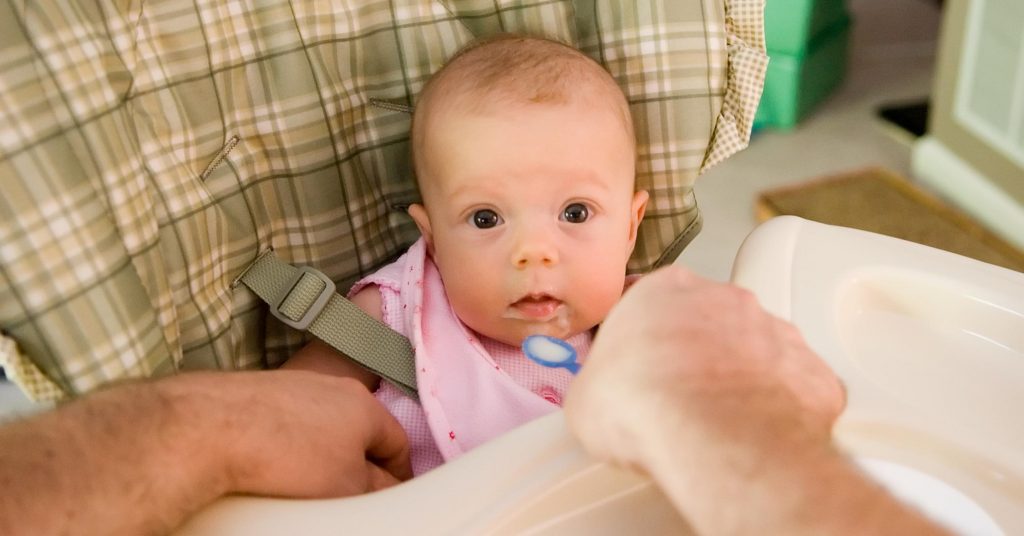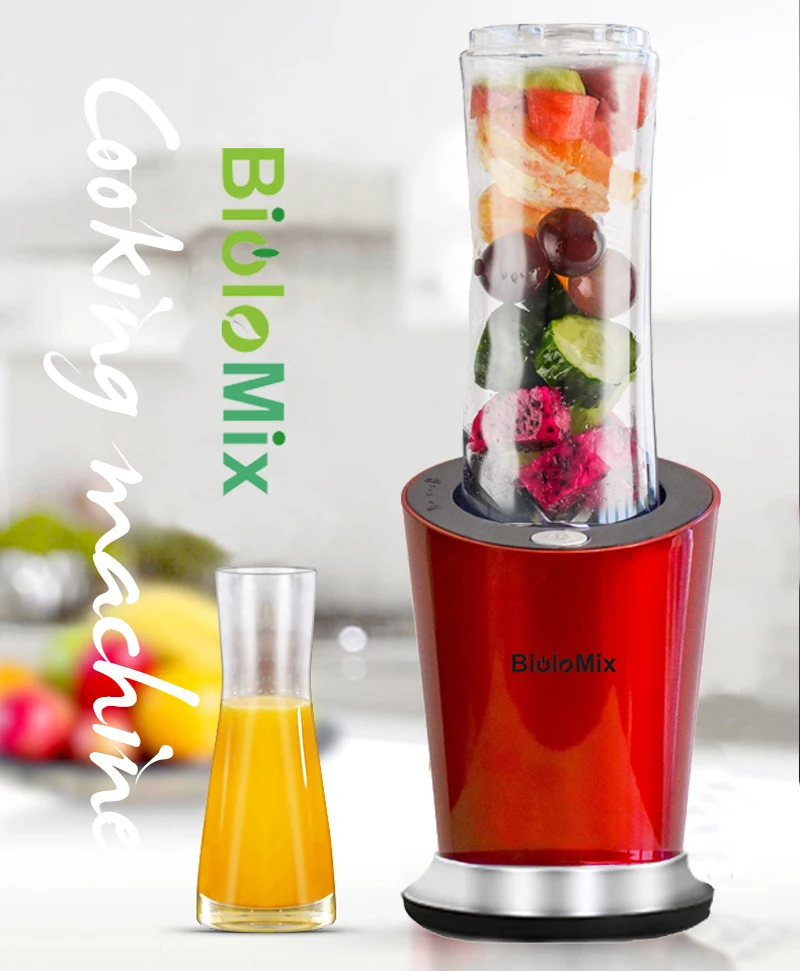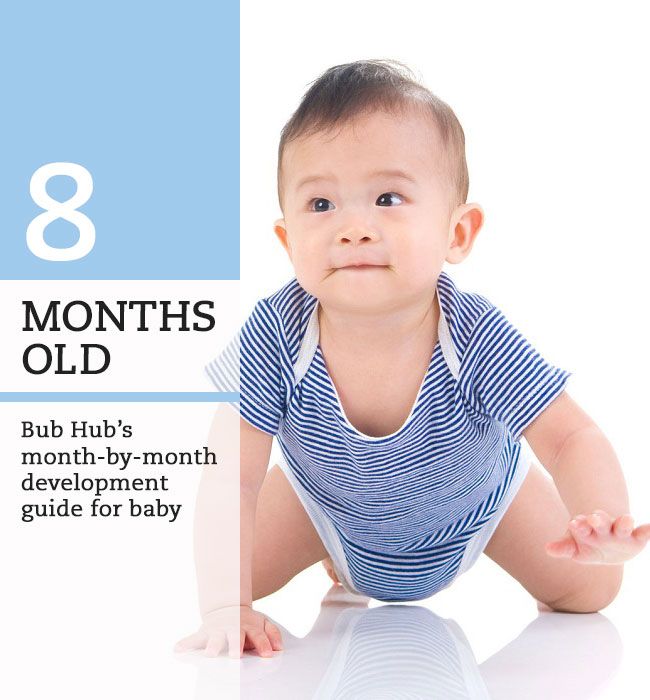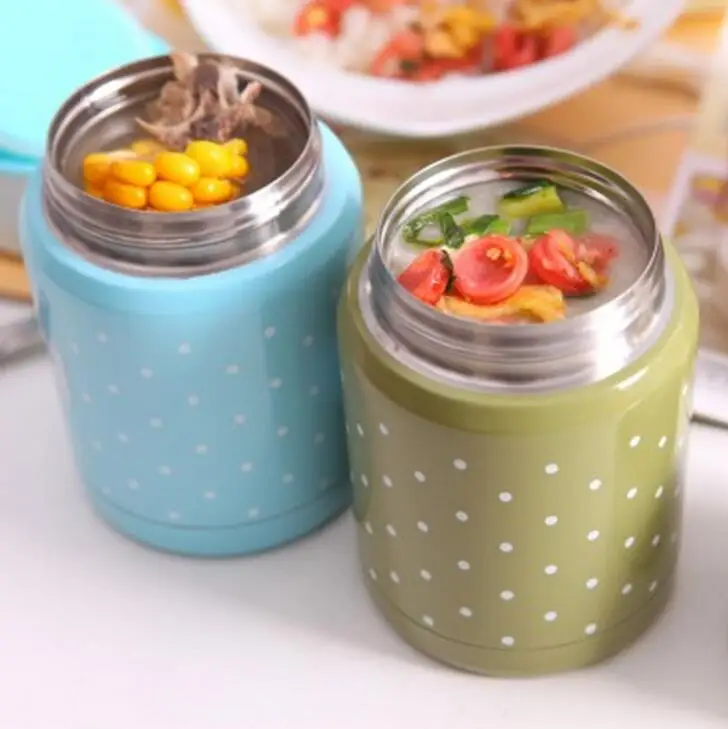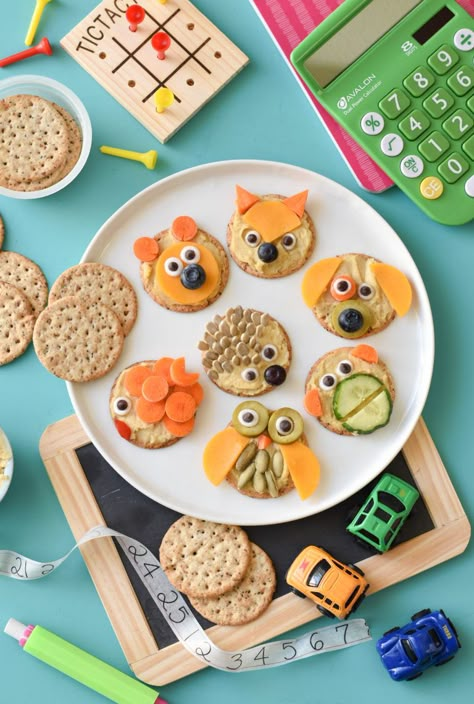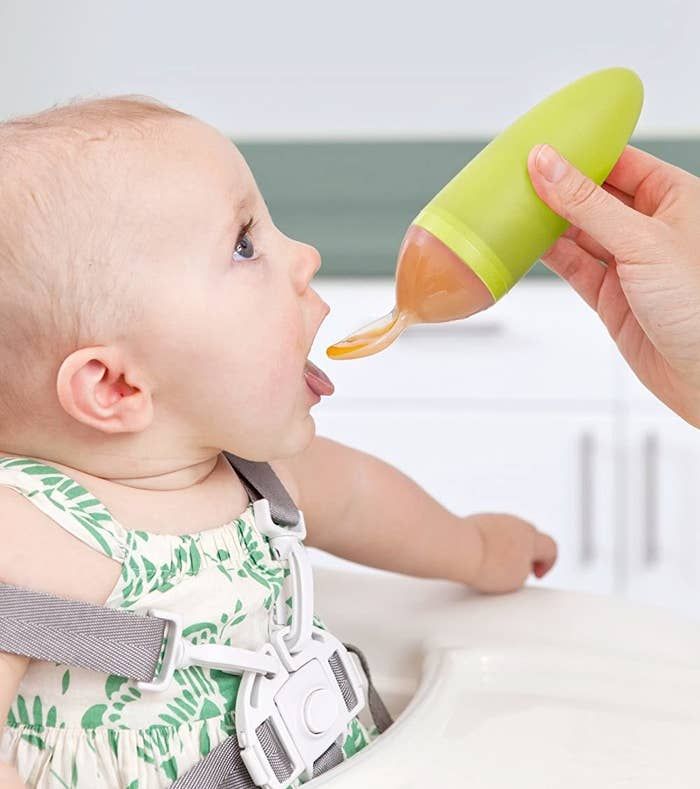Feeding strawberries to babies
Strawberries for Babies - When Can Babies Eat Strawberries
When can babies eat strawberries?
Strawberries may be introduced as soon as a baby is ready for solids, which is generally around 6 months of age. Note that strawberries range in size and not all strawberries will be appropriate for babies, so read our age-based section closely.
Need more ideas for baby’s first solid foods? Check out our guides.
Strawberry varieties
Strawberries grow in temperate regions worldwide, and humans have been harvesting wild strawberries and learning to cultivate the fruit for centuries. There are tons of varieties to try – some the size of your fingernail, others the size of your hand; some red or pink, others purple or white; some deliciously sweet, others tart like pineapple. From the delicate Alpine strawberry to the hefty Fragaria Chandler, there are many varieties to explore.
Strawberries ripen on their runners, and unlike bananas, they do not continue to ripen after they are picked. Those plump, heart-shaped berries in plastic shells at American grocery stores? These strawberries are grown to maximize productivity and harvested early so that they can be packaged and shipped from California or Florida, the top strawberry-producing regions in the United States. They can taste very different from strawberries that are grown near your home or found in the wild.
Are strawberries healthy for babies?
Yes. Strawberries are packed with vitamin C, which strengthens immunity and helps baby’s body absorb iron from plant-based foods.1 The fruit also contains fiber, which promotes a healthy gut, as well as folate that fuels a baby’s metabolism, cell energy, and antioxidant activity. The seeds even contain some omega-3 fatty acids to power a baby’s vision, nervous system, and brain development. 2 The best part about strawberries: the fruit contains more than 50 polyphenols, which are plant compounds that act as antioxidants and anti-inflammatory agents to keep a baby’s cells and whole body healthy.3
2 The best part about strawberries: the fruit contains more than 50 polyphenols, which are plant compounds that act as antioxidants and anti-inflammatory agents to keep a baby’s cells and whole body healthy.3
Strawberries are commonly sprayed with pesticides.4 To minimize exposure, thoroughly wash strawberries before serving them and if your budget allows for it, buy organic fresh or frozen strawberries.5
★Tip: Love strawberry jam? It would be wise to hold off on serving jam until after the 2nd birthday because it is packed with added sugar.6 Instead, simply mash strawberries to make a fresh jam that can be stirred into oatmeal or yogurt, thickened with chia seeds, or served on its own.
Are strawberries a choking hazard for babies?
Yes. Strawberries are a potential choking hazard, especially when the fruit is firm, round, or small. To minimize the risk, first choose very large, soft and ripe berries. Large strawberries (much bigger than baby’s mouth) can be served whole as long as you supervise baby closely..jpg) Small, round, or firm strawberries should be thinly sliced or smashed. As always, make sure to create a safe eating environment and stay within arm’s reach of baby at mealtime. For more information on choking, visit our sections on gagging and choking and familiarize yourself with the list of common choking hazards.
Small, round, or firm strawberries should be thinly sliced or smashed. As always, make sure to create a safe eating environment and stay within arm’s reach of baby at mealtime. For more information on choking, visit our sections on gagging and choking and familiarize yourself with the list of common choking hazards.
Are strawberries a common allergen?
No. Strawberry is not considered to be a common allergen, although allergenic proteins in the strawberry fruit have been identified.7 Interestingly, the strawberry proteins that cause allergic reactions are less likely to be found in white strawberries. What’s more common than allergy is a harmless skin reaction around the mouth from the acidity of the fruit. Although not an allergic reaction, strawberries and other acidic fruits can also cause or worsen diaper rash when consumed in excess. If this occurs, apply a thick barrier cream or ointment to the diaper area and limit prolonged contact with a wet/dirty diaper.
Individuals with Oral Allergy Syndrome (also known as pollen food allergy syndrome), particularly those who are allergic to birch pollen, may be sensitive to strawberries. Oral Allergy Syndrome typically causes mild, temporary itching, tingling, or burning in the mouth, which usually resolves on its own.8 9 Cooking the fruit can minimize the reaction.10
Strawberry is a part of the Rosaceae family, and individuals who are sensitive to other plants in this family (such as almonds, apples, and plums) may have a similar experience with strawberries.11
As you would when introducing any new food, start by offering a small quantity at first. If there is no adverse reaction, gradually increase the amount served over future meals.
How do you prepare strawberries for babies with baby-led weaning?
Every baby develops on their own timeline, and the suggestions on how to cut or prepare particular foods are generalizations for a broad audience.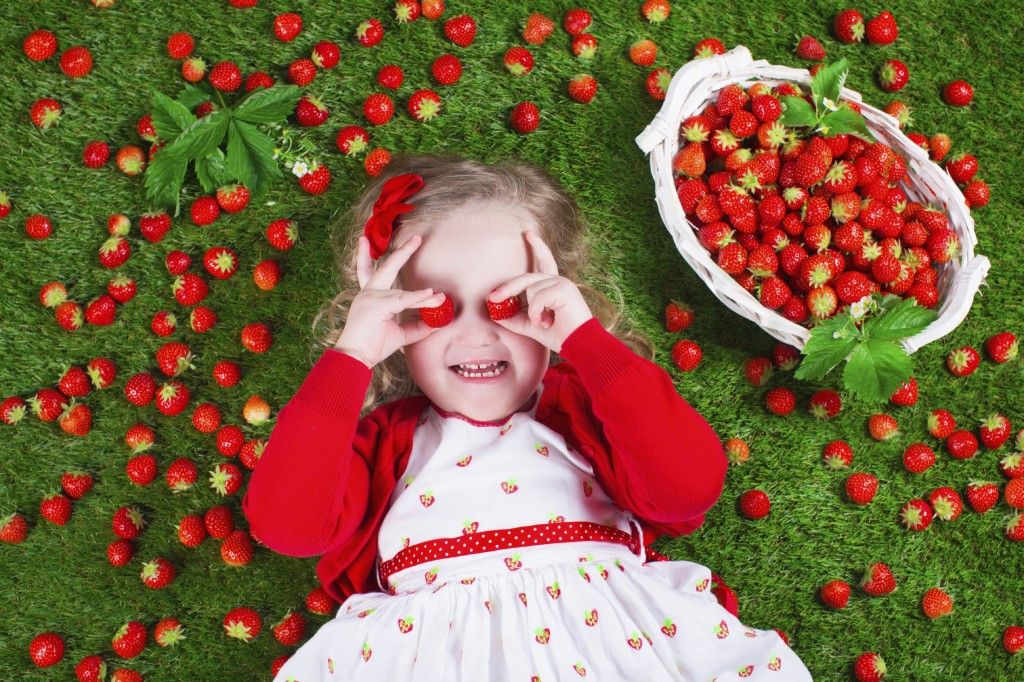 Your child is an individual and may have needs or considerations beyond generally accepted practices. In determining the recommendations for size and shape of foods, we use the best available scientific information regarding gross, fine, and oral motor development to minimize choking risk. The preparation suggestions we offer are for informational purposes only and are not a substitute for child-specific, one-on-one advice from your pediatric medical or health professional or provider. It is impossible to fully eliminate all risk of a baby or child choking on any liquid, puree, or food. We advise you to follow all safety protocols we suggest to create a safe eating environment and to make educated choices for your child regarding their specific needs. Never disregard professional medical advice or delay in seeking it because of something you have read or seen here.
Your child is an individual and may have needs or considerations beyond generally accepted practices. In determining the recommendations for size and shape of foods, we use the best available scientific information regarding gross, fine, and oral motor development to minimize choking risk. The preparation suggestions we offer are for informational purposes only and are not a substitute for child-specific, one-on-one advice from your pediatric medical or health professional or provider. It is impossible to fully eliminate all risk of a baby or child choking on any liquid, puree, or food. We advise you to follow all safety protocols we suggest to create a safe eating environment and to make educated choices for your child regarding their specific needs. Never disregard professional medical advice or delay in seeking it because of something you have read or seen here.
6 to 9 months old: If your strawberries are very big and very soft and ripe, you can offer a whole strawberry (stem removed) if you feel comfortable. If the whole berry is able to fit into the child’s mouth, it is too small and should be sliced or mashed. To check if the berry is soft enough, press it between your fingers and make sure it gives under slight pressure. If you have to press hard for it to give, it is too firm. Similarly, if the berry gets munched down to a size that makes you uncomfortable, remove the berry and replace with a new, large berry. If your strawberries are small, mash or slice the fruit before serving. To help baby consume more mashed strawberries, stir the fruit into yogurt or warm cereal.
If the whole berry is able to fit into the child’s mouth, it is too small and should be sliced or mashed. To check if the berry is soft enough, press it between your fingers and make sure it gives under slight pressure. If you have to press hard for it to give, it is too firm. Similarly, if the berry gets munched down to a size that makes you uncomfortable, remove the berry and replace with a new, large berry. If your strawberries are small, mash or slice the fruit before serving. To help baby consume more mashed strawberries, stir the fruit into yogurt or warm cereal.
9 to 12 months old: At this age, you can start offering thin slices of strawberry. Note that paper-thin slices will likely be difficult for babies to pick up and may stick to baby’s tongue or the roof of their mouth.
12 to 24 months old: Continue with sliced strawberries, and when you feel the toddler is ready, move back up in size and offer large whole or quartered strawberries.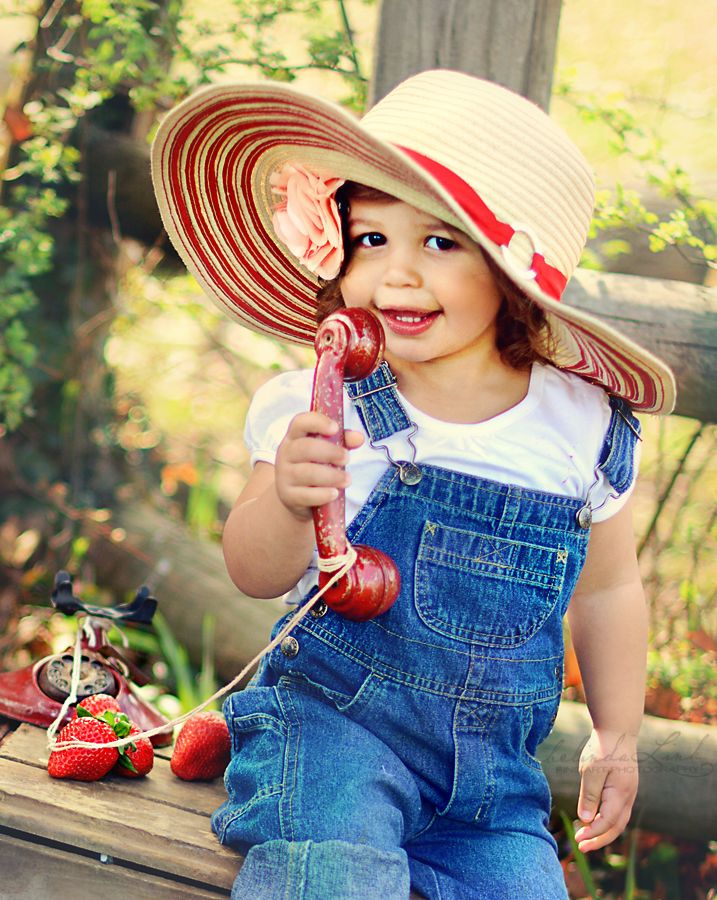 The more ripe and soft the berry, the lower the risk.
The more ripe and soft the berry, the lower the risk.
For more information on how to cut food for babies, visit our page on Food Sizes & Shapes.
Why are strawberries sometimes very tart and other times very sweet?
The flavor depends on the variety of strawberry – some types are more acidic, while others are sweeter. The flavor also depends on how the fruit was grown and harvested.
Recipe: Strawberry Oatmeal
Yield: 1 ½ cup (365 grams)
Cooking Time: 5 minutes
Age: 6 months+
Ingredients
- ½ cup (40 grams) dry instant oatmeal or rolled oats
- 1 cup (250 milliliters) water or milk of choice
- ½ cup (75 grams) fresh or frozen strawberries
- 1 pinch ground cardamom, cinnamon, nutmeg, or spice of choice (optional)
- 1 pinch ground almond or nut of choice (optional)
This recipe contains optional ingredients that are common allergens: almond (tree nut) and milk (dairy). Only serve to a child after these allergens have been introduced safely.
Only serve to a child after these allergens have been introduced safely.
Directions
- Combine the oatmeal and water in a small pot. Bring to a boil, then lower the heat to a bare simmer.
- Cook, stirring frequently, until the oatmeal thickens, about 5 minutes.
- Remove the pot from the heat and let cool.
- Wash and dry the strawberries, making sure they are ripe and soft. If you are not sure, press the berry between your fingers. If it gives easily under pressure, it should be soft enough. Mash half of the strawberries, then stir into the oatmeal. Cut the other half of the strawberries into age-appropriate sizes – see our suggestions in the age-based section.
- If you like, stir the spice into the oatmeal and sprinkle ground almond on top.
- Scoop some strawberry oatmeal into the child’s bowl. Exact serving size is variable. Let a child’s appetite determine how much is eaten.
- Serve the strawberry oatmeal with the cut-up berries on top or on the side.
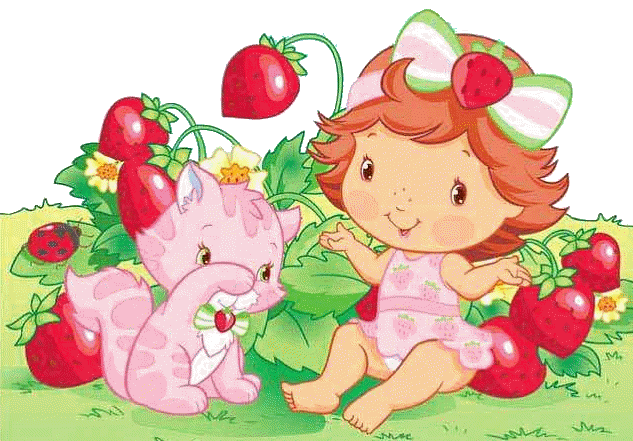 Let the child self-feed by scooping with hands. If you’d like to encourage the use of a utensil, simply pre-load a spoon and rest it next to the bowl for the child to pick up. Alternatively, pass the pre-loaded spoon in the air for the child to grab from you.
Let the child self-feed by scooping with hands. If you’d like to encourage the use of a utensil, simply pre-load a spoon and rest it next to the bowl for the child to pick up. Alternatively, pass the pre-loaded spoon in the air for the child to grab from you.
To Store: Strawberry oatmeal keeps in an air-tight container in the fridge for 1 week. Cut strawberry keeps in an air-tight container in the fridge for 3 days.
If you could use some more recipe ideas, check out our breakfast guide to make your mornings just a bit easier.
Flavor Pairings
Strawberries have a tart-sweet flavor (some sweeter than others!) that pairs well with grassy vegetables like artichoke, asparagus, or rhubarb; leafy greens like kale and spinach; fresh beans like fava beans, garden peas, green beans, snap peas, and snow peas; and earthy nuts and grains like almond, amaranth seed, and quinoa. Try enhancing a strawberry’s flavor with lemon, lime, orange, and other citrus; warm seasonings like cardamom, cinnamon, orange water, rose water, or vanilla; or pungent herbs like basil or mint.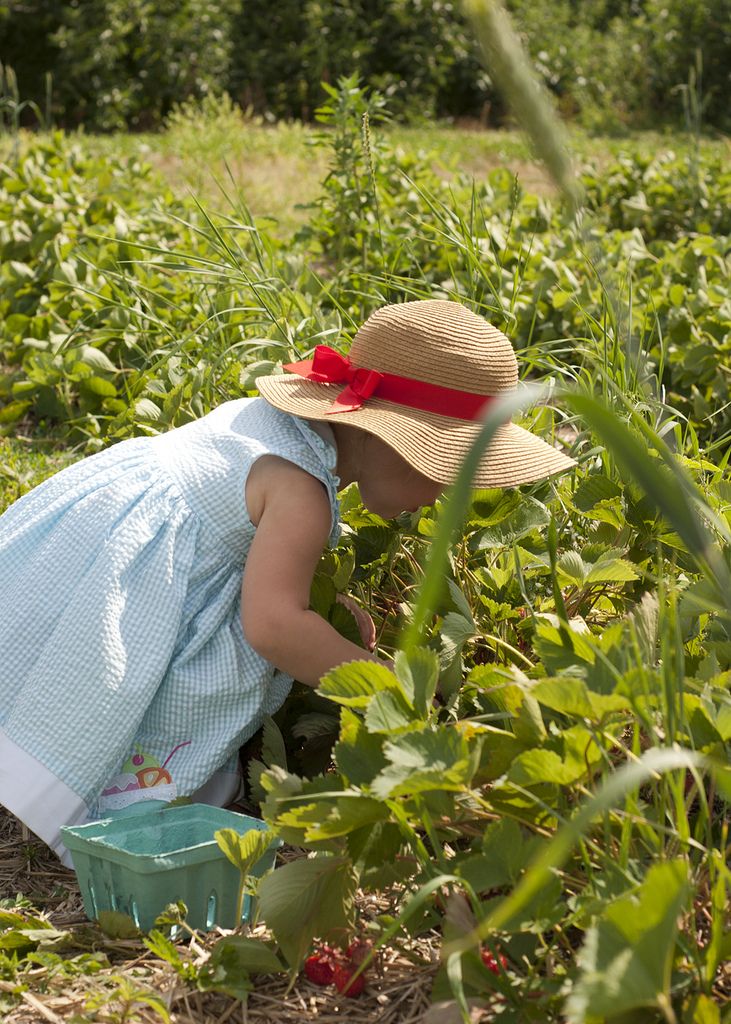 Strawberries taste delicious with similarly sweet-tart fruits like blueberry, kiwi, or pineapple and creamy foods like coconut, goat’s cheese, mascarpone cheese, ricotta cheese, and yogurt.
Strawberries taste delicious with similarly sweet-tart fruits like blueberry, kiwi, or pineapple and creamy foods like coconut, goat’s cheese, mascarpone cheese, ricotta cheese, and yogurt.
Reviewed by
J. Truppi, MSN, CNS
V. Kalami, MNSP, RD
K. Rappaport, OTR/L, MS, SCFES, IBCLC
K. Grenawitzke, OTD, OTR/L, SCFES, IBCLC, CNT
S. Bajowala, MD, FAAAAI. Board-Certified Allergist & Immunologist (allergy section)
R. Ruiz, MD Board-Certified General Pediatrician and Pediatric Gastroenterologist
- Friel, J., Qasem, W., & Cai, C. (2018). Iron and the Breastfed Infant. Antioxidants, 7(4), 54. DOI:10.3390/antiox7040054. Retrieved May 25, 2021.
- Jurgoński, A., Fotschki, B., Juśkiewicz, J. (2015). Dietary strawberry seed oil affects metabolite formation in the distal rt intestine and ameliorates lipid metabolism in rats fed an obesogenic diet. Food & nutrition research, 59, 26104.
 DOI:10.3402/fnr.v59.26104. Retrieved May 25, 2021.
DOI:10.3402/fnr.v59.26104. Retrieved May 25, 2021. - Gasperotti M, Masuero D, Mattivi F, et al. (2015). Overall dietary polyphenol intake in a bowl of strawberries: The influence of Fragaria spp. in nutritional studies. Journal of Functional Foods, 18(B), 1057-1069. DOI:10.1016/j.jff.2014.08.013. Retrieved May 25, 2021.
- Lozowicka B, Jankowska M, Hrynko I, Kaczynski P. (2016). Removal of 16 pesticide residues from strawberries by washing with tap and ozone water, ultrasonic cleaning and boiling. Environ Monit Assess, 188(1):51. DOI:10.1007/s10661-015-4850-6. Retrieved May 27, 2021.
- Lozowicka B, Jankowska M, Hrynko I, Kaczynski P. (2016). Removal of 16 pesticide residues from strawberries by washing with tap and ozone water, ultrasonic cleaning and boiling. Environ Monit Assess, 188(1):51. DOI:10.1007/s10661-015-4850-6. Retrieved May 27, 2021.
- Fidler Mis, N., Braegger, C., Bronsky, J., Campoy, C., Domellöf, et al. (2017). Sugar in Infants, Children and Adolescents: A Position Paper of the European Society for Paediatric Gastroenterology, Hepatology and Nutrition Committee on Nutrition.
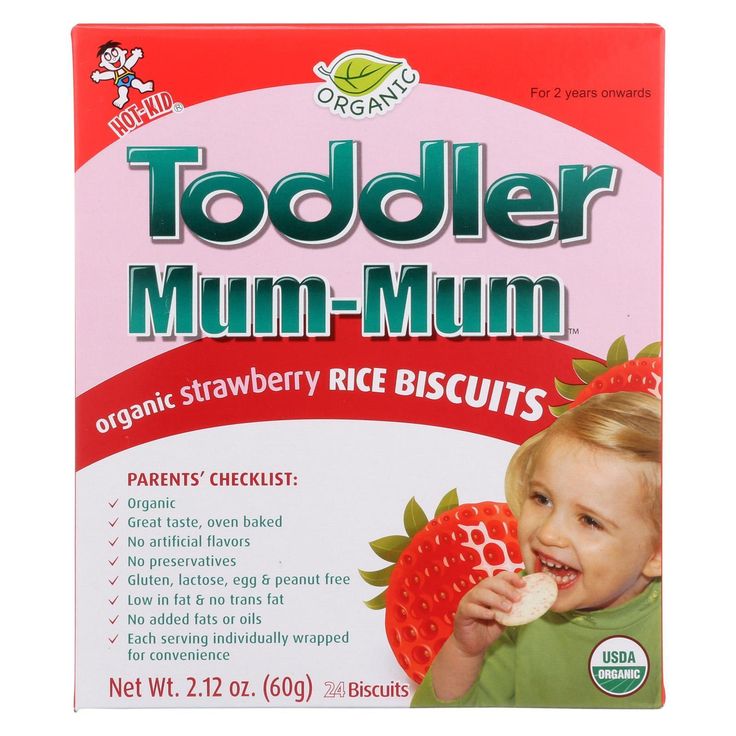 Journal of pediatric gastroenterology and nutrition, 65(6), 681–696. DOI:10.1097/MPG.0000000000001733. Retrieved August 25, 2020.
Journal of pediatric gastroenterology and nutrition, 65(6), 681–696. DOI:10.1097/MPG.0000000000001733. Retrieved August 25, 2020. - Cabrera-Freitag, P., Bermejo Becerro, A., Abreu Ramírez, M. G., Álvarez-Perea, A., Infante Herrero, S., et al. (2020). Allergy to Strawberry in Children From the Mediterranean Area: Is It Really Allergy? Journal of investigational allergology & clinical immunology, 30(4), 283–285. DOI:10.18176/jiaci.0491. Retrieved May 25, 2021.
- Muluk, N.B., Cingi, C. (2018). Oral allergy syndrome. American journal of rhinology & allergy, 32(1), 27–30. DOI: 10.2500/ajra.2018.32.4489. Retrieved August 14, 2020.
- Worm, M., Jappe, U., Kleine-Tebbe, J., Schäfer, C., Reese, I., et al. (2014). Food allergies resulting from immunological cross-reactivity with inhalant allergens: Guidelines from the German Society for Allergology and Clinical Immunology (DGAKI), the German Dermatology Society (DDG), the Association of German Allergologists (AeDA) and the Society for Pediatric Allergology and Environmental Medicine (GPA).
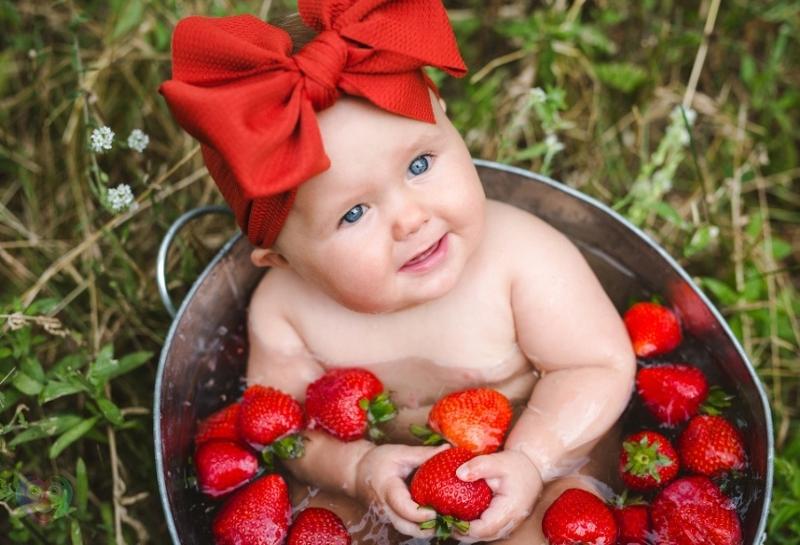 Allergo journal international, 23(1), 1–16. DOI:10.1007/s40629-014-0004-6. Retrieved May 25, 2021.
Allergo journal international, 23(1), 1–16. DOI:10.1007/s40629-014-0004-6. Retrieved May 25, 2021. - Nowak-Wegrzyn, A. (2021). Patient Education: Oral Allergy Syndrome (Beyond the Basics). Retrieved May 25, 2021.
- Rodriguez, J., Crespo, J. F., Lopez-Rubio, A., De La Cruz-Bertolo, J., Ferrando-Vivas, P., et al. (2000). Clinical cross-reactivity among foods of the Rosaceae family. The Journal of allergy and clinical immunology, 106(1 Pt 1), 183–189. DOI:10.1067/mai.2000.106927. Retrieved May 25, 2021.
How to Serve Strawberries to Baby
Home » Feeding Style » Baby Food Purees » Stage One » How to Serve Strawberries to Baby
Learn how to prepare strawberries for baby in 10 delicious and easy ways! As yummy superfoods, strawberries are a great first food for babies 4-6 months and up. Serve them as a baby food puree, as a solid for the finger food stage or for baby-led weaning.
Medically reviewed and co-written by Jamie Johnson, Registered Dietitian Nutritionist (RDN), and Lauren Braaten, Pediatric Occupational Therapist (OT).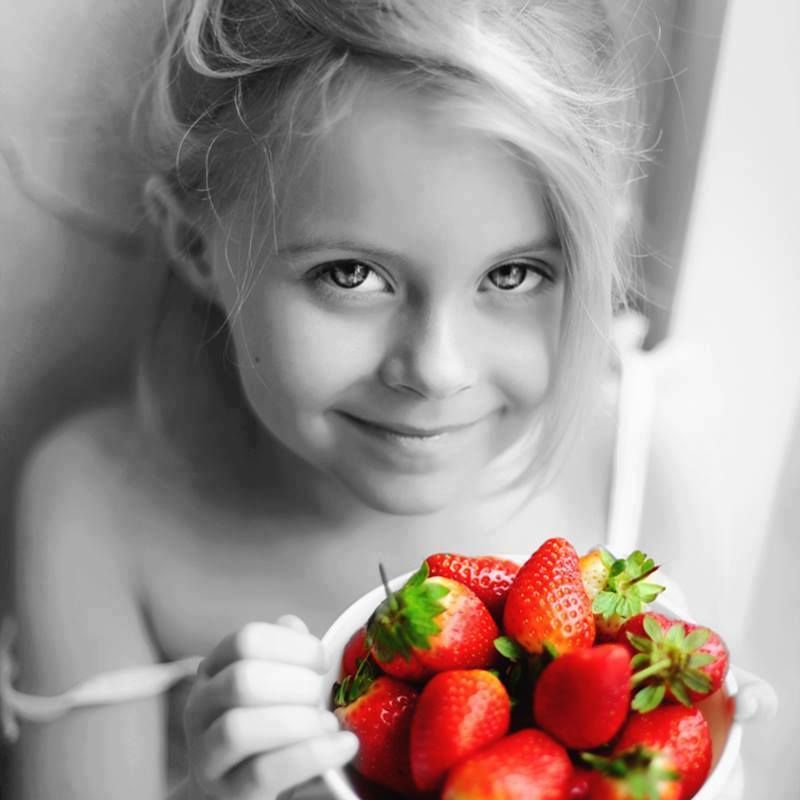
Who doesn’t love a fresh ripe strawberry? 🍓
And by no means, do we want baby to miss out on tasting and (hopefully) enjoying such a scrumptious fruit!
Below you will find all the information you need to know about when you can introduce strawberries to your baby as well as how to serve them to your baby regardless if you are making purees, doing baby-led weaning, a combo of both, or are in the finger food stage! Because no matter where you are in your feeding journey, your baby definitely needs to experience the magic of fresh strawberries.
First time making homemade baby food? Then, I would suggest that you start by reading my very in-depth Guide on how to Make Homemade Baby Food – which goes over all the important information such as the best cooking tools to have on hand, safe storage, how to know when baby is ready for solids, how to introduce purees, the best first foods for baby, and more! If you are doing Baby-Led Weaning, then be sure to check out my Complete Guide to Baby-Led Weaning – which covers what exactly is baby-led weaning, to every parent’s concern of baby-led weaning and choking, this guide goes over it all.![]() I will also share how to know when baby is ready for BLW, the top 10 best first foods, a helpful sample blw feeding schedule, helpful tools to have on hand, and much much more!
I will also share how to know when baby is ready for BLW, the top 10 best first foods, a helpful sample blw feeding schedule, helpful tools to have on hand, and much much more!
Want more information? Then make sure to check out my best-selling cookbook for even more information and recipes!
Strawberries for Baby Video
Watch this video to see all the ways you can serve strawberries to your baby!
Reasons to Love these Strawberry Recipes- delicious baby food purees – 4-6+ months
- great for baby-led weaning – 6+ months
- also great for the finger food stage – 9+ months
- full of essential nutrients for baby
- different ways for baby to eat – spoon-fed or self-feed
- easy to make
- purees are freezer-friendly
- can use fresh or frozen strawberries
Strawberries are super healthy for a number of reasons:
- Nutritious: Strawberries are full of important vitamins and minerals that benefit our health.
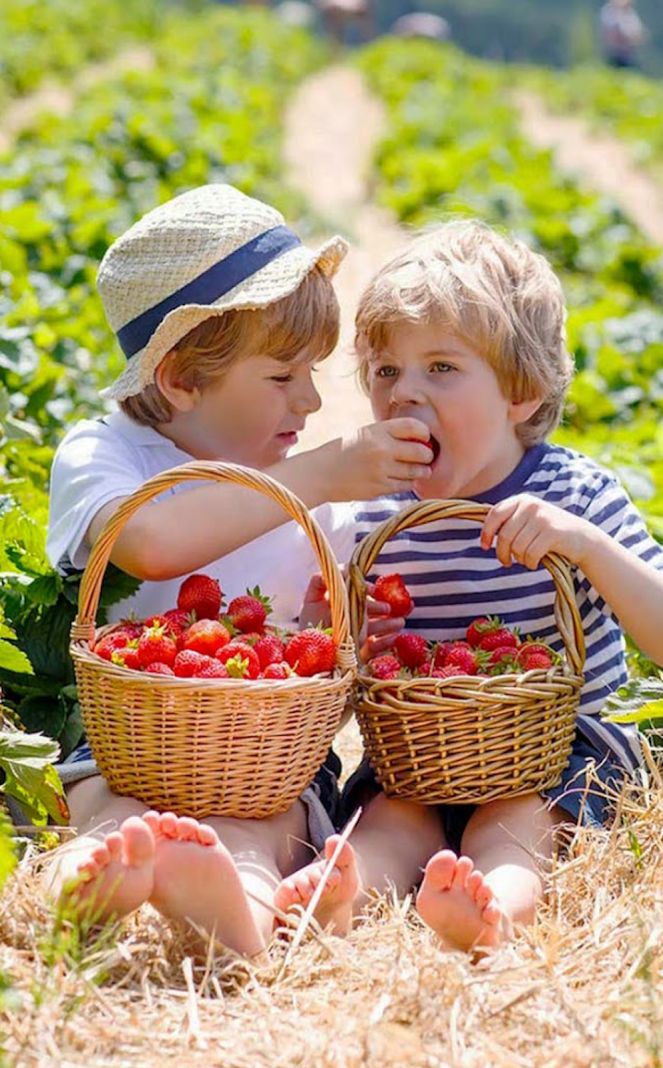 They are high in vitamin C; in fact, one cup contains about 180% of the recommended Daily Value for kids, making it an excellent source of this vitamin. They’re also a good source of fiber and contain potassium, folate, and numerous antioxidants. A majority of strawberries are made up of water, so they are a great food to keep your baby hydrated.
They are high in vitamin C; in fact, one cup contains about 180% of the recommended Daily Value for kids, making it an excellent source of this vitamin. They’re also a good source of fiber and contain potassium, folate, and numerous antioxidants. A majority of strawberries are made up of water, so they are a great food to keep your baby hydrated. - Health Benefits: Due to the many nutrients in strawberries, they have been linked to heart health, cancer prevention, digestive health, immune health, blood sugar stability, and reduced inflammation.
Frozen vs. Fresh Strawberries: if fresh strawberries are not in season or in your budget, frozen strawberries would be a great option for you. They are nutritionally similar and easy to find in most grocery stores.
Frequently Asked Questions
When can you introduce strawberries to baby?
Whether you’re starting your baby on purees or are doing baby-led weaning, strawberries are a wholesome and enjoyable first food for your baby! When a baby can start on solids is determined by their own rate of development, which generally comes between 4-6 months of age for purees and or after 6 months for baby-led weaning. Some of the developmental milestones your baby needs to reach in order to start on solids include: if your baby has solid control of their head and neck, if your baby has doubled in weight, and if your baby is reaching for or opening their mouth when you eat (see my guide here). Before you start your baby’s feeding journey, you should consult with your pediatrician to make sure your child is developmentally ready.
Some of the developmental milestones your baby needs to reach in order to start on solids include: if your baby has solid control of their head and neck, if your baby has doubled in weight, and if your baby is reaching for or opening their mouth when you eat (see my guide here). Before you start your baby’s feeding journey, you should consult with your pediatrician to make sure your child is developmentally ready.
Are strawberries a choking hazard to baby?
Yes, strawberries can be a choking hazard, depending on how they are served and the developmental readiness of your baby. To minimize the risk of choking, serve soft and ripe strawberries in age-appropriate forms. For babies under 6 months, serve mashed or as a puree. For ages 6-9 months, you can serve them whole (stems removed), larger than a golf ball size. 9 months and older can have quartered or thinly sliced strawberries, and if the pincer grasp has developed, you can serve them diced.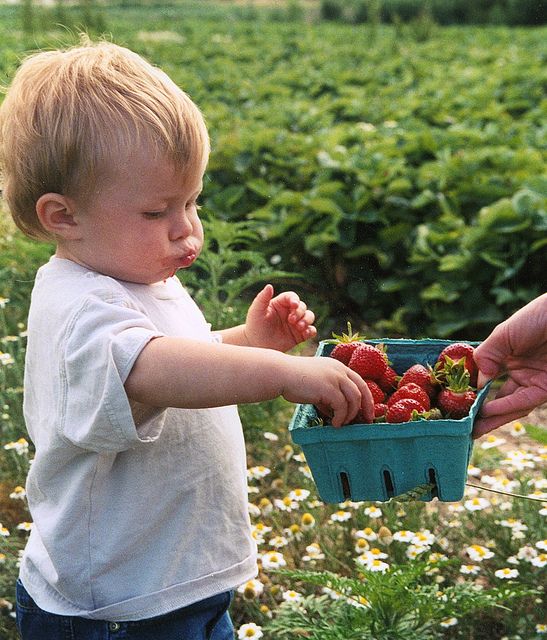 Never leave your baby unattended while eating.
Never leave your baby unattended while eating.
Are strawberries a common allergen?
Strawberries are not one of the top eight food allergens, so it’s not a very common allergy; however, a small percentage of children do develop an allergy due to a protein in the anthocyanins (what gives them their red color) in strawberries, making white strawberries more tolerable, but many do outgrow it. Cooking strawberries will denature this protein, so people with allergies may still be able to enjoy strawberries in a jam, sauces, and baked goods.
How to Serve Strawberries to BabyThere are several different ways to prepare strawberries for your baby! You can make them into a smooth puree, a combination puree, a chunky puree for stage three, mashed and spread on toast or whole for baby-led weaning or a finger food. Here are 10 of my favorite ways to serve them:
Stage One Purees- Roasted Strawberry Puree
- Simmered Strawberry Puree
- Beaba Babycook Blueberry Puree
- 2-Minute Strawberry Puree
- 6 Delicious Combination Purees
- Mashed Strawberries with Carrots & Beans
- Chunky Strawberry Puree with Yogurt
- Strawberries for Baby-Led Weaning or Finger Foods: whole, quartered, sliced or chopped
- Mashed Strawberries with Carrots & Beans
- Chunky Strawberry Puree with Yogurt
These tools will make it a lot easier for you to serve strawberries to your baby.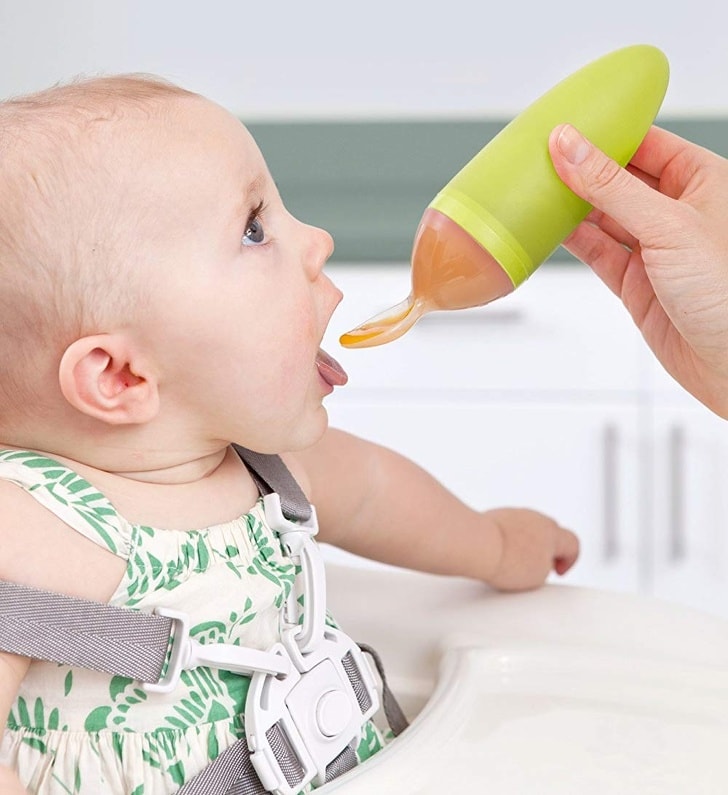 For more of my favorite kitchen tools make sure to check out my shop.
For more of my favorite kitchen tools make sure to check out my shop.
- Baby Bowls
- Suction Baby Plates
- Baby Spoons
- Beaba Babycook
- Freezer Storage Tray
- Gootensil
- Saucepan
- Baking Sheet
This has to be one of my favorite ways to make a smooth strawberry puree for your baby as the high heat of the oven condenses the natural sugars in the strawberries, which brings out the deep rich sweetness from the strawberries. This simple cooking technique is a simple way to make a puree that is truly swoon-worthy! Of course, if you want to take a serving of your baby’s puree and use it on top of ice cream, I, for one, will not stop you;).
How to Serve: you can serve this puree as-is, mixed with an apple, pear, or sweet potato puree, swirled into oatmeal, yogurt, or ricotta.
Instructions (see below for the full recipe): chop strawberries and place them on a baking sheet. Roast in an oven for 20 minutes until the strawberries are bursting with juices. Place the roasted strawberries in a blender or food processor and puree until smooth.
Roast in an oven for 20 minutes until the strawberries are bursting with juices. Place the roasted strawberries in a blender or food processor and puree until smooth.
This simmered puree is a simple and easy way to make a yummy strawberry puree for your baby. While simmering, some of the strawberry’s natural water content evaporates, leaving a thicker and sweeter puree. This is helpful because if you blend strawberries into a puree, the puree will be thinner.
How to Serve: you can serve this puree as-is, mixed with an apple, pear, or carrot puree, swirled into oatmeal, yogurt, or ricotta.
Instructions (see below for the full recipe): chop strawberries and place them in a small saucepan. Heat for 10 minutes until the strawberries are super soft and falling apart. Place the simmered strawberries into a blender or food processor and puree until smooth.
Strawberry Tip: this is a great recipe for using frozen strawberries.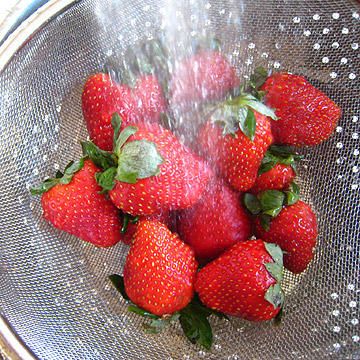 You can add frozen strawberries straight to the saucepan and simmer for 12-14 minutes or until soft and thawed through.
You can add frozen strawberries straight to the saucepan and simmer for 12-14 minutes or until soft and thawed through.
Who doesn’t love an easy, delicious, and homemade puree that you can make your baby with the push of a button? Using the BEABA Babycook, you can make a simple puree for your baby, highlighting the season’s flavors with minimal effort.
How to Serve: you can make this puree with just strawberries, or you can add in a handful of chopped apples, sweet potatoes, pear, or carrots into the stainless steel basket before steaming.
Instructions (see below for the full recipe): chop strawberries and place them into the steamer basket. Fill the water tank to level 1. Place the steamer basket inside the glass jar, close the lid and push the steam button. Once done, pour out any excess water, transfer the cooked strawberries into the glass jar, close the lid and push the blend button until smooth.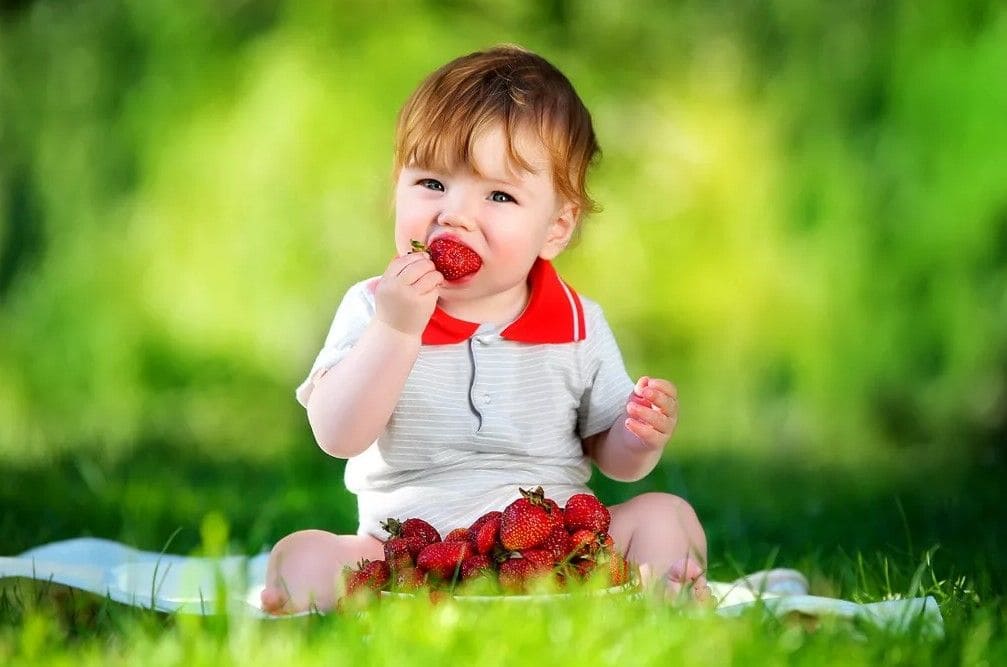
Full Review: read my full, in-depth and honest review of the BEABA Babycook Neo here! Make sure to grab 15% off your Babycook with code (BabyFoode15)!
2-Minute Strawberry PureeWant to make a delicious strawberry puree for baby but are short on time? Then this puree recipe is for you! We are simply going to blend up some fresh strawberries and call it a day! Yes, it can be that easy.
Instructions (see below for the full recipe): cut off the strawberry greens, and place the strawberries into a blender (chopped or whole). Blend for 1-2 minutes or until smooth. If the seeds are too much for your baby, you can strain them in a fine mesh colander. This puree will start on the thinner side but will thicken in the fridge as it cools.
Strawberries for Self-FeedingStrawberries are a great food for your baby to self-feed, whether for baby-led weaning, which happens around 6 months of age, or during the finger foods stage at 9 months.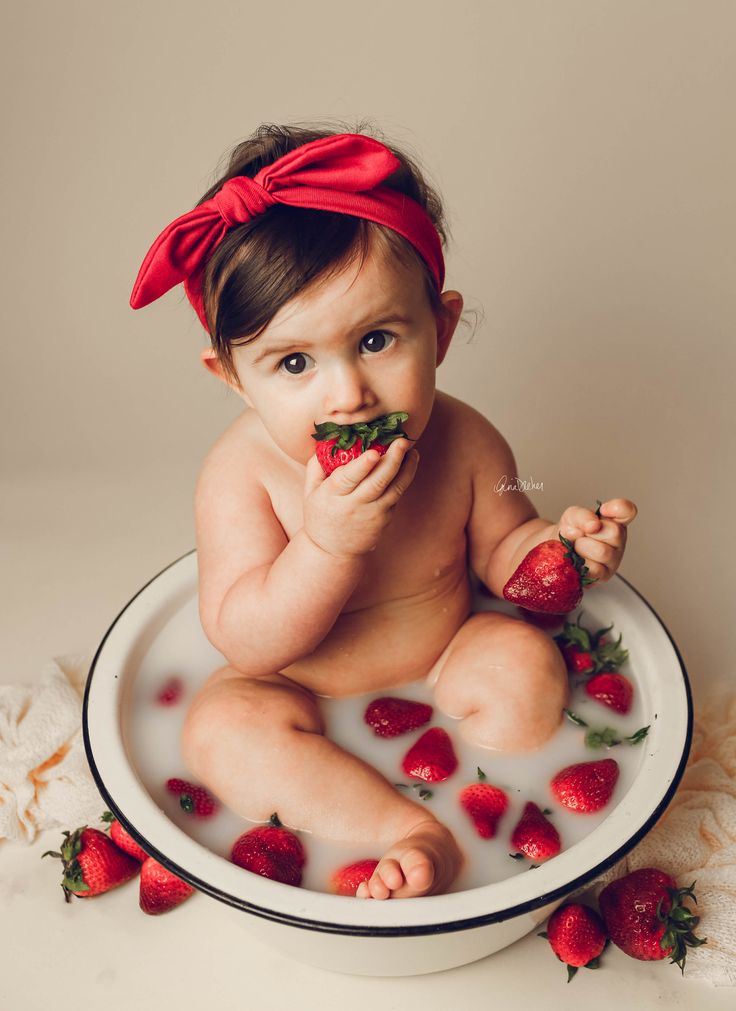
Whole: great for babies 6+ months or just starting on solid foods. It’s best to start your baby with a bigger piece of strawberry so your baby can chew, gnaw and take bites without them being a choking hazard.
Quartered: you can serve baby quartered or thinly sliced strawberries at 9 months and older.
Chopped: if your baby’s pincer grasp has been developed, you can serve them diced strawberries around 9-10 months.
6 Strawberry Combination PureesYou can mix and match strawberries with many other great fruits and veggies to make a fun combination puree. Here are my 6 favorites.
- Banana Strawberry Puree: place 2 ripe bananas and 1 cup of chopped strawberries in a blender and puree until smooth. Freeze immediately to preserve the color.
- Avocado Strawberry Puree: on a cutting board, mash 1/2 a ripe avocado with 2 chopped strawberries until super smooth.
 Freeze immediately to preserve the color.
Freeze immediately to preserve the color. - Sweet Potato Strawberry Puree: follow this sweet potato recipe but add chopped strawberries to the backing sheet when you have 20 minutes left on your cooking time. Puree as instructed in the recipe.
- Apple Strawberry Puree: follow this apple puree recipe, but add 1-2 cups of chopped strawberries when you add in the apples. Puree as instructed in the recipe.
- Carrot Strawberry Puree: follow this carrot puree recipe, but add 1-2 cups of chopped strawberries while blending.
- Pear Strawberry Puree: follow this pear puree recipe, but add 1-2 cups of chopped strawberries when you add the pears to the saucepan. Cook and puree as instructed in the recipe.
This mashed strawberries, carrots, and beans for your baby is a great way to serve your baby a full meal in one tasty bite. You can serve this chunky puree on a piece of toast, spoon-feed it to baby, toss it with some pasta and let baby self-feed it to themselves, swirl it into some yogurt or ricotta or load a self-feeding spoon with a bite and hand the spoon to your baby.
You can serve this chunky puree on a piece of toast, spoon-feed it to baby, toss it with some pasta and let baby self-feed it to themselves, swirl it into some yogurt or ricotta or load a self-feeding spoon with a bite and hand the spoon to your baby.
Instructions (see below for the full recipe): place a strawberry, steamed carrots, and a few beans on a cutting board and, using the back of a fork, mash until chunky and incorporated with each other.
More Flavors: you can also use steamed or roasted sweet potatoes, avocado, banana, soft tofu, cooked and shredded chicken, cooked and shredded salmon, and more!
Looking for more easy baby-led weaning and puree recipes? Then check out my favorite ways to serve apples, avocados and bananas to babies!
Chunky Strawberry Puree with YogurtFinely chopped strawberries paired with a thick plain yogurt – yes, please! This is a protein-packed food for your baby! Of course, you can also use cottage cheese or ricotta if you want to get all fancy.
How to Serve: you can serve this to your baby on a spoon, a self-feeding spoon, or on a piece of toast, pancake, or waffle.
Instructions (see below for the full recipe): finely chop strawberries and add yogurt, mix well. Serve to baby on a piece of toast or load onto a self-feeding spoon.
Strawberry OatmealOatmeal is one of my favorite things to serve baby because you can make it into a smooth puree for stage one, thicker chunky oatmeal for stage three, or you can spoon some dollops of oatmeal onto a plate and let it completely cool before serving it for baby-led weaning or the finger food stage. It really does grow with your baby. In this recipe, we will cook the strawberries with oats so that the two turn into beautiful pink porridge. And don’t worry if you want to save yourself a portion of this oatmeal for yourself! You can top your portion with a drizzle of honey, slices of banana and strawberries, and a sprinkle of chopped nuts.
Instructions (see below for the full recipe): bring water to a boil and add in oats, strawberries and a pinch of cinnamon. Let cook, stirring often, for 10 minutes, let cool slightly. Serve as is, or transfer to a blender and puree until you have your desired consistency.
More Oatmeal Inspiration: love oatmeal and need more ideas on how to serve it to your baby? Then check out my complete Oatmeal for Babies guide.
Storage InstructionsYou can freeze any of the purees listed above. For finger foods, you can store any leftovers in the fridge in an air-tight container for up to 3 days.
RefrigeratorYou can store the strawberry puree in an airtight container in the fridge for 3 days.
FreezerThis strawberry puree can be frozen for up to 3 months.
- Spoon pureed strawberry into a freezer storage container (this is my favorite freezer storage container) – do not overfill.

- Place the lid on the storage container or cover with a piece of saran wrap and label with date and recipe name.
- Place the tray into the freezer and let freeze completely – preferably overnight.
- Pop-out the baby food cubes and place in a zip-lock baggie or stasher bag – don’t forget to re-label the baggie or stasher bag for future reference.
Recipe Tips
- Picking Strawberries: you will want to get a package of strawberries that are bright red, medium in size, and with vivid greens. Make sure to avoid any moldy or overly soft strawberries.
- Organic Strawberries: Since strawberries are on the EOG Dirty Dozen list, I recommend purchasing organic strawberries if possible. In some areas and with some budgets, this is not possible. Do your best! I don’t always buy organic strawberries since they can run upwards of $9 a pint in the winter months where I live, which is too much for my budget. Buying organic is easier during the summer months, and frozen organic strawberries are always a great option.
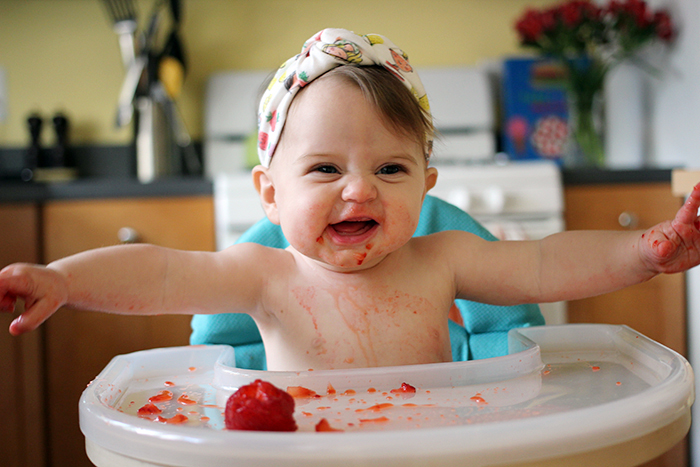
- Fresh or Frozen: You can use either fresh or frozen strawberries for any of the puree, mashed or chunky recipes below, you will need to thaw and drain the strawberries first. It is best to use fresh strawberries if serving as a solid as they will easier for your baby to pick up and hold.
- Blender: Because strawberries condense down to such a small amount of puree, I use a small blender when pureeing any of these recipes. You can also use a handheld emersion blender or food processor. You can also double the recipe if you still want to use your regular-sized blender.
Or watch a shortened version of this video here.
Roasted Strawberry Puree
- 2 cups strawberries, stems removed and chopped
- 1 pinch cinnamon (optional)
Simmered Strawberry Puree
- 2 cups strawberries, stems removed, chopped (fresh or frozen)
- 2 tbsp water
- 1 tsp fresh lemon juice (optional)
Beaba Babycook Strawberry Puree
- 2 cups strawberries, stems removed, chopped (fresh or frozen)
- water
2-Minute Strawberry Puree
- 2 cups strawberries, stems removed, chopped (fresh or frozen)
Baby-Led Weaning/Finger Food Stage
- 1-2 strawberries, stems removed
Strawberry Oatmeal
- 1 cup water
- 1 cup strawberries, stems removed, chopped (fresh or frozen)
- 1/2 cup old-fashioned oats
- pinch cinnamon
Mashed Strawberry, Carrots & Beans
- 1 strawberry, stems removed, chopped (fresh or frozen)
- 1 tbsp white beans, canned or pre-cooked
- 1 tbsp steamed carrots, roughly chopped
Strawberry & Yogurt
- 1 strawberry, stem removed and finely chopped
- 1 tbsp plain whole milk yogurt
Roasted Strawberry Puree
Preheat oven to 425° F.
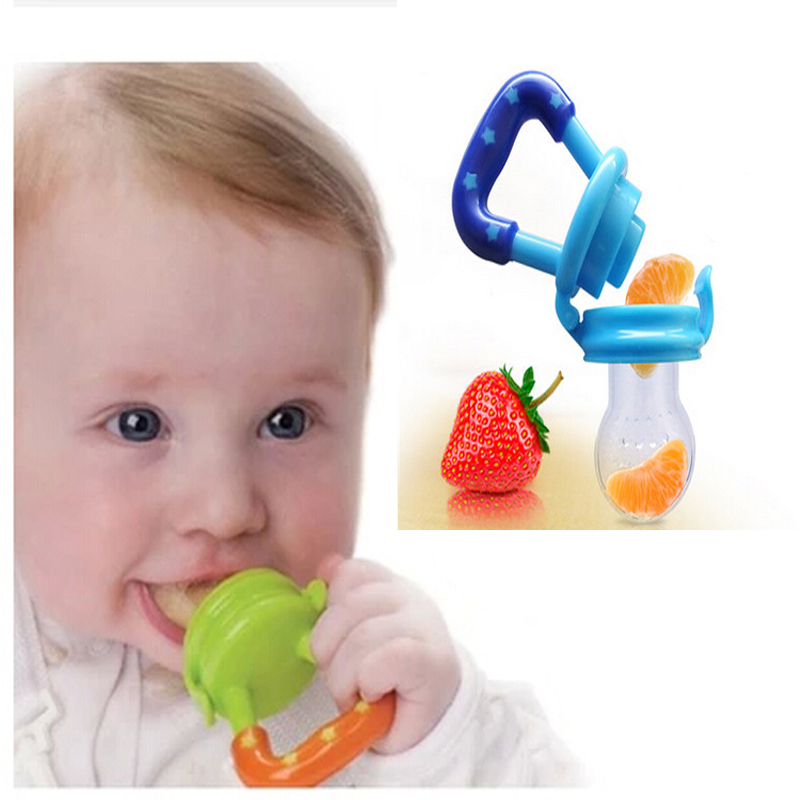 Line a baking sheet with parchment paper. Place the strawberries on the baking sheet and sprinkle on cinnamon. Bake for 20 minutes or until soft and bursting with juices.
Line a baking sheet with parchment paper. Place the strawberries on the baking sheet and sprinkle on cinnamon. Bake for 20 minutes or until soft and bursting with juices.Let cool slightly and then transfer the strawberries to a blender or food processor and puree for 1-2 minutes until smooth.
Simmered Strawberry Puree
Place the strawberries, water, and lemon juice into a small saucepan and heat over medium-low heat for 10-12 minutes or until soft and broken down.
Let cool slightly and then transfer the strawberries to a blender or food processor and puree for 1-2 minutes until smooth.
Beaba Babycook Strawberry Puree
Fill the tank reservoir to level 1 with water. Add the strawberries to the stainless steel basket and place the basket into the glass jar. Place the lid on top and close. Push the steam button.
Once complete, remove the lid and let cool slightly. Take the stainless steel basket out of it and then pour any excess water into a measuring cup; reserve.
 Next, pour the strawberries into the glass jar, close the lid, and push and hold the blend button until the strawberries are smooth, adding in any reserved strawberry water if needed.
Next, pour the strawberries into the glass jar, close the lid, and push and hold the blend button until the strawberries are smooth, adding in any reserved strawberry water if needed.
2-Minute Strawberry Puree
Place the chopped strawberries into a blender and puree for 1-2 minutes or until smooth.
If there are too many seeds, pour the puree through a fine mesh colander into another bowl. The puree will thicken as it cools in the fridge or freezer.
Baby-Led Weaning/Finger Food Stage
Serve to baby whole, sliced, quartered or chopped depending on your baby's age (see graph)
Strawberry Oatmeal
In a small saucepan, bring the water to a boil. Add in oats, strawberries, and cinnamon. Cook for 10 minutes or until the oats are cooked, and most of the water is gone. Using a hand mixer or blender, puree the oats to your desired consistency – smooth, slightly chunky, or chunky. If serving for baby-led weaning, dollop a few 2-inch circles of oatmeal on a plate and place it in the fridge.
 Once cooled, the oatmeal will be easier for your baby to pick up and self-feed.
Once cooled, the oatmeal will be easier for your baby to pick up and self-feed.
Mashed Strawberry, Carrots & Beans
Place the strawberry, carrots, and beans onto a cutting board. Using the back of a fork, mash the ingredients together into a chunky puree.
Spread the chunky puree onto a 1-3 inch piece of toast, load it onto a gootensil, place on a plate for your baby to eat with their hands, or spoon feed it to your baby.
Strawberry & Yogurt
Place the strawberry on a cutting board or in a small bowl. Add in the yogurt and stir until incorporated. Serve to your baby with a gootensil, place on a plate for baby to eat with their own hands, or spoon feed it to your baby.
Age: 4-6+ months for puree, 6+ months for baby-led weaning.
Storage: you can store the purees in the fridge for up to 4 days or in the freezer for 4 months. You can store the finger foods in the fridge for up to 3 days.
Yield: the purees will yield you roughly 6-8 ounces of puree, while the finger foods will give you 1-2 servings.
Notes on Frozen Strawberries: if you are using frozen strawberries, make sure you thaw and drain any excess liquid before using them.
Blender
Tripp Trapp High Chair
Freezer Tray
Bumkins Grip Plate
Did you make this recipe?
Tag @babyfoode on Instagram and hashtag it #babyfoode!
Pin Recipe Email a Friend
This post is sponsored by BEABA Babycook. Thank you for supporting the brands that support Baby FoodE!
At what age can strawberries be given to a child?
In our article we will talk about the benefits of strawberries, about the age at which you can give strawberries to a child, and also share recipes for simple children's strawberry dishes.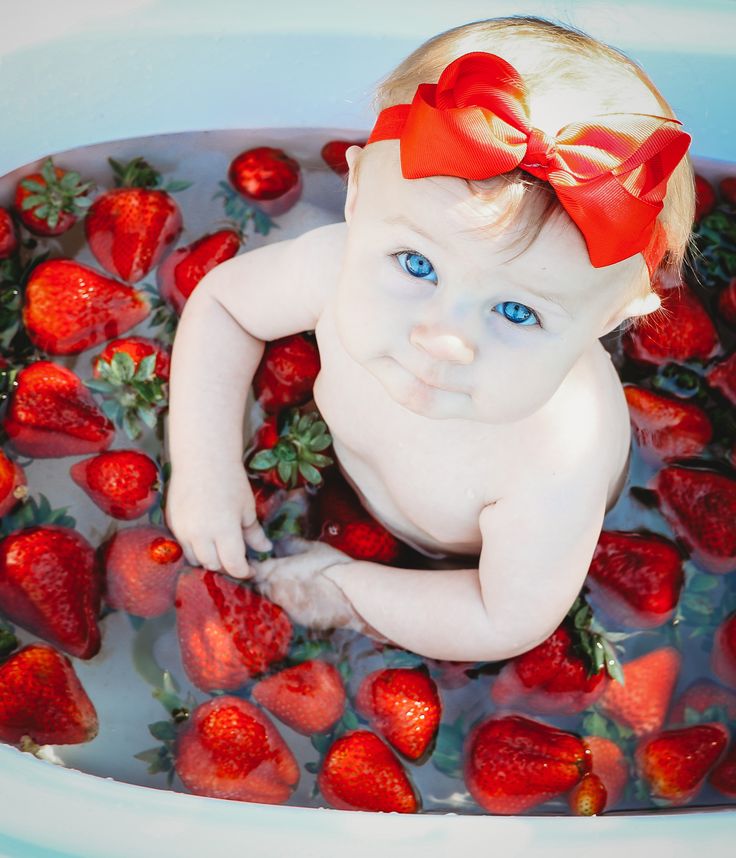 We also recall that it is convenient to follow the timing of the introduction of complementary foods and a particular product using our complementary foods table.
We also recall that it is convenient to follow the timing of the introduction of complementary foods and a particular product using our complementary foods table.
Read also: How to choose strawberries? (video)
Vitamins, micro and macro elements in strawberries
100 grams of strawberries contain 41 kcal
| Vitamins | Macronutrients | Microelements |
| Vitamin PP - 0.3 mg Beta-carotene - 0.03 mg Vitamin A (RE) - 5 mcg Vitamin B1 (thiamine) - 0.03 mg Vitamin B2 (riboflavin) - 0.05 mg Vitamin B5 (pantothenic) - 0.3 mg Vitamin B6 (pyridoxine) - 0.06 mg Vitamin B9 (folic) - 20 mcg Vitamin C - 60 mg Vitamin E (TE) - 0.5mg Vitamin H (biotin) - 4 mcg Vitamin PP (niacin equivalent) - 0. | Calcium - 40 mg Magnesium - 18 mg Sodium - 18 mg Potassium - 161 mg Chlorine - 16 mg Sulfur - 12 mg | Iron - 1.2 mg Zinc - 0.097 mg Iodine - 1 mcg Copper - 125 mcg Manganese - 0.2 mg Chromium - 2 mcg Fluorine - 18 mcg Molybdenum - 10 mcg Boron - 185 mcg Vanadium - 9 mcg Cobalt - 4 mcg Nickel - 2 mcg |
Composition and nutritional properties of strawberries
100 g strawberries contain:
- Proteins - 0.8 g
- Fat - 0.4 g
- Carbohydrates - 7.5 g
- Dietary fiber - 2.2 g
- Organic acids - 1.3 g
- Water - 87.4 g
- Mono- and disaccharides - 7.4 g
- Starch - 0.1 g
- Ash - 0.4 g
Benefits of strawberries for children
Strawberries contain many biologically active substances: sugar, organic acids, calcium, iodine, phosphorus, iron, potassium, pectins.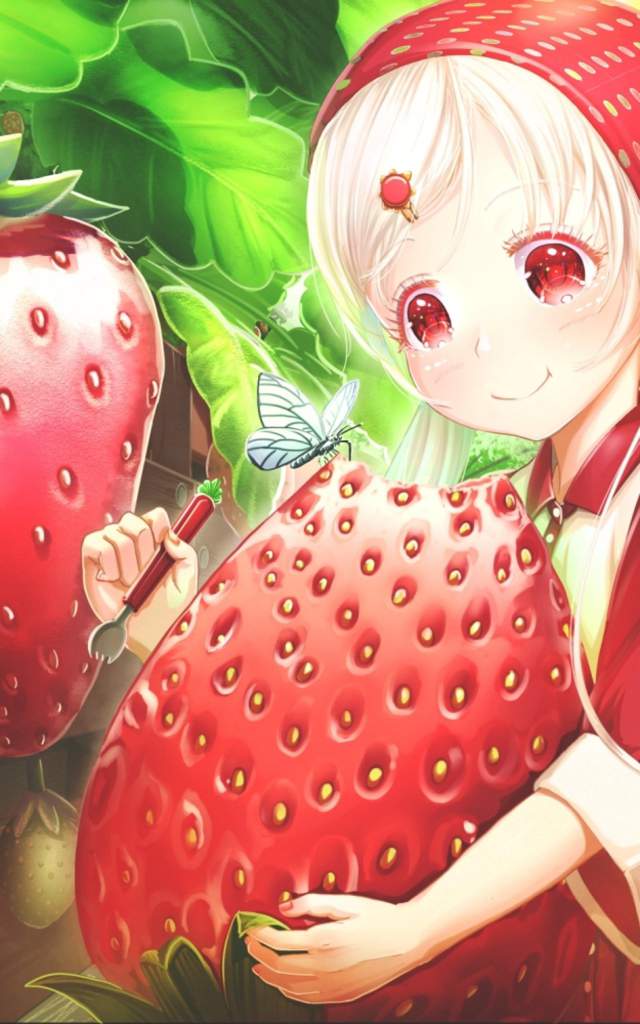 It also contains a large amount of vitamin C, folic acid. Strawberries strengthen the walls of blood vessels, the immune system. The benefits of strawberries for children also lie in the ability to resist viral bacteria and relieve inflammation. Freshly squeezed juice can be used in the treatment of stomatitis in children, as well as antibacterial and analgesic for sore throats in children.
It also contains a large amount of vitamin C, folic acid. Strawberries strengthen the walls of blood vessels, the immune system. The benefits of strawberries for children also lie in the ability to resist viral bacteria and relieve inflammation. Freshly squeezed juice can be used in the treatment of stomatitis in children, as well as antibacterial and analgesic for sore throats in children.
Read also: What to prepare from strawberries: a recipe for tender and fragrant strawberry kurds
strawberries for children: at what age
from what age can children be strawberries
as we have already convinced, strawberries, strawberries very useful, especially for a growing and developing organism, so parents are in a hurry to introduce it into their children's diet. But the main danger that can lurk in ripe fruits is the high risk of allergies. Therefore, the answer to the question: “At what age can strawberries be given to a child?” - will depend on how prone the baby is to allergic reactions.
When can I give strawberries to my child? Pediatricians recommend introducing these berries into the children's diet no earlier than a year, when the baby's digestive system normalizes, and the immune system will not react so strongly to all red foods.
When introducing strawberries into the diet, like any other new product, the following rules should be followed:
- start with a small amount;
- give an unfamiliar product in the morning;
- not compatible with other new products;
- monitor for possible skin reactions and stool changes.
Is it possible for children under one year old to have strawberries and how it will affect the baby's health, no one can predict, even a family doctor, so all responsibility lies on the conscience of the parents. Is the benefit of strawberries worth the risk? You decide.
Is it possible to give a one-year-old child strawberries? If the child is not prone to diathesis and other manifestations of allergies, no negative reactions were noticed during the introduction of complementary foods, and the berry season is in full swing, it is worth trying to give the baby one berry in combination with a dairy product that neutralizes the effect of the allergen.
Pediatricians advise: before offering the fruit itself to a child, first pour boiling water over strawberries, let it brew and let the child taste the juice. Then you can give a little with some water and pulp. If there is no allergic reaction, you can give the child a fresh berry.
Even if the child is not allergic to strawberries, do not give more than two or three berries a day.
Read also: I have an idea! How to freeze strawberries
Contraindications for use
Despite the fact that strawberries contain many useful substances and vitamins, this is a strong allergen. Based on this, it is not recommended to use it for allergy sufferers, pregnant, lactating, children under two years of age, as well as people suffering from frequent hepatic colic, high acidity of gastric juice, gastritis.
The best products for children from 0 to 3 years old
Strawberry recipes for children
Strawberries can be consumed fresh (with yogurt or cream). You can also cook mousse, jelly, compote, fruit salad, jelly, pancakes, cheesecakes, dumplings.
You can also cook mousse, jelly, compote, fruit salad, jelly, pancakes, cheesecakes, dumplings.
Strawberry soufflé (from two years old)
Ingredients:
- Strawberries - 250 g;
- Sugar - 1 tbsp. a spoon;
- Gelatin - 1 tbsp. a spoon.
Preparation:
First you need to wash the strawberries and add sugar to them, grind in a blender. Then bring the puree to a boil on the stove and cool. Add gelatin to it while stirring. Then pour the soufflé into molds, cool and refrigerate.
Read also: Recipe of the week. Strawberry ice cream cake
Strawberry marshmallow (from 3 years old)
Ingredients:
- g;
- Sugar - 200 g;
- Proteins (quail) - 6 pcs;
- Gelatine - 10g
Preparation:
First you need to puree strawberries and sugar with a blender, bring it to a boil, and then cook for 15 minutes over low heat. Then you need to beat the egg whites until foamy and add them to the puree. Pour the mixture into molds and chill in the refrigerator.
Then you need to beat the egg whites until foamy and add them to the puree. Pour the mixture into molds and chill in the refrigerator.
Strawberry cottage cheese (from 2 years old)
Ingredients:
- Cottage cheese - 50 g;
- Strawberries - 2-3 pcs.;
- Sour cream - 1 teaspoon;
- Sugar - 1 tsp.
Preparation:
The recipe is very simple - you need to grind strawberries with sour cream, sugar and cottage cheese in a blender. The dish is ready!
For more recipes, see Baby Food
Read about when to introduce new foods into your baby’s diet, about the beneficial properties of these foods and how to diversify your baby’s menu with new dishes, read in Encyclopedia of Baby Food and cheese (9-12 months)
Read also: Zucchini in the baby’s diet: a useful product
Read also: First baby food: 3 simple vegetable puree recipes
how to feed strawberries at home
how to feed strawberries during fruiting
There are 3 main fertilizers that any plant needs, including strawberries: nitrogen, phosphorus and potassium.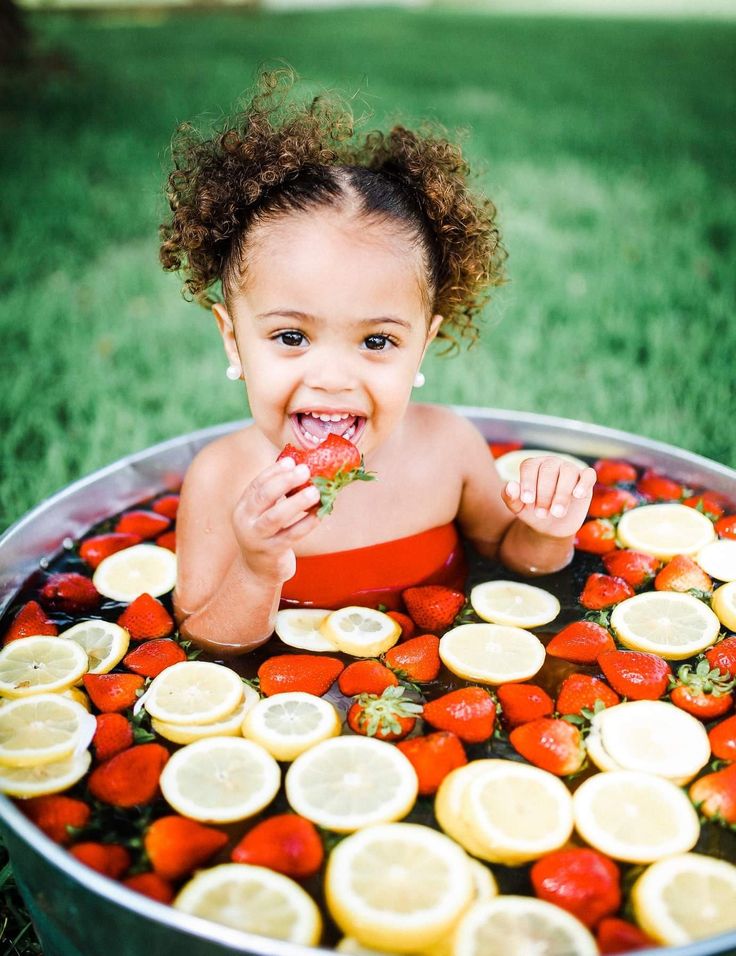 These are the so-called macronutrients. And the rule here is this:
These are the so-called macronutrients. And the rule here is this:
- nitrogen is introduced at the beginning of active growth - it is needed for growth;
- Phosphorus is applied before flowering - it stimulates the formation of flowers;
- Potassium is applied at the beginning of fruiting - it is responsible for the ripening of the crop.
Of course, this is a somewhat exaggerated story, since all these elements are responsible for many functions, but these are the main ones. And it's so easy to understand what the plant needs at the moment.
Consequently, during fruiting, strawberries need more potassium - without it, the berries will be small, sour, and the yield will decrease (1).
Fertilizing options
The main potash fertilizer is applied as soon as the first berries begin to set: 1 tbsp. a spoonful of potassium sulfate per 10 liters of water. Consumption rate - a bucket per 1 sq. m.
Usually this is enough, but you can feed strawberries with trace elements:
- boron: boric acid at the tip of a knife in a bucket of water - this top dressing will help speed up the ripening of berries;
- zinc: 2 g of zinc sulfate per bucket of water will increase yield.
In both cases, the consumption rate is 10 liters per 1 sq. m. - It must be evenly scattered around the plants, a handful for each bush. Ash contains a large amount of potassium and a lot of macronutrients - just everything that strawberries need.
Feeding strawberries with mullein
This advice is indeed often found on the Internet, but it can be classified as harmful. The main nutrient in mullein is nitrogen. And, as we found out, it is necessary for the active growth of the plant.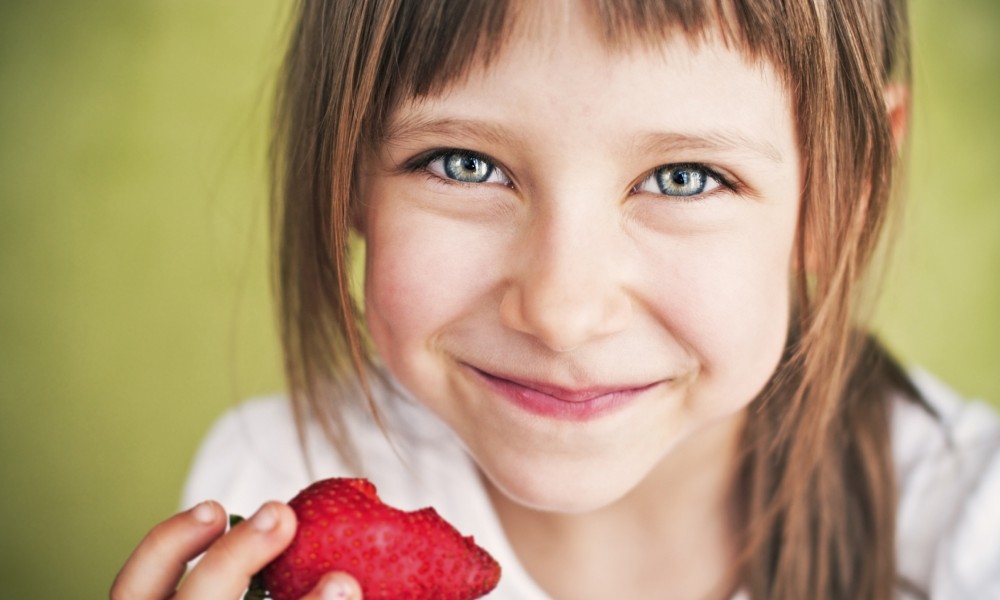 If you feed strawberries with mullein at the time of fruiting, it will provoke active leaf growth to the detriment of the crop. In addition, the berries will become watery and will quickly rot.
If you feed strawberries with mullein at the time of fruiting, it will provoke active leaf growth to the detriment of the crop. In addition, the berries will become watery and will quickly rot.
– Feeding with mullein will be appropriate later, says agronomist Svetlana Mikhailova. - For example, if in the middle of summer you cut the leaves of strawberries, then it is useful to fertilize it with nitrogen, the same mullein. It will help strawberries grow new green mass. It must be applied immediately after pruning. It is not worth delaying nitrogen fertilization, at the end of summer they are inappropriate, since they can reduce the frost resistance of plants.
Photo: pixabay.comMullein infusion is prepared as follows: 1/2 bucket of manure is poured into 5 liters of water, covered with a lid and put in a warm place so that it ferments. On average, fermentation lasts a week.
As a result, a mother solution will be obtained, which must be diluted with water in a ratio of 1:3 or 1:4 (2) before use, that is, 250 - 300 ml of the solution per 10 liters of water.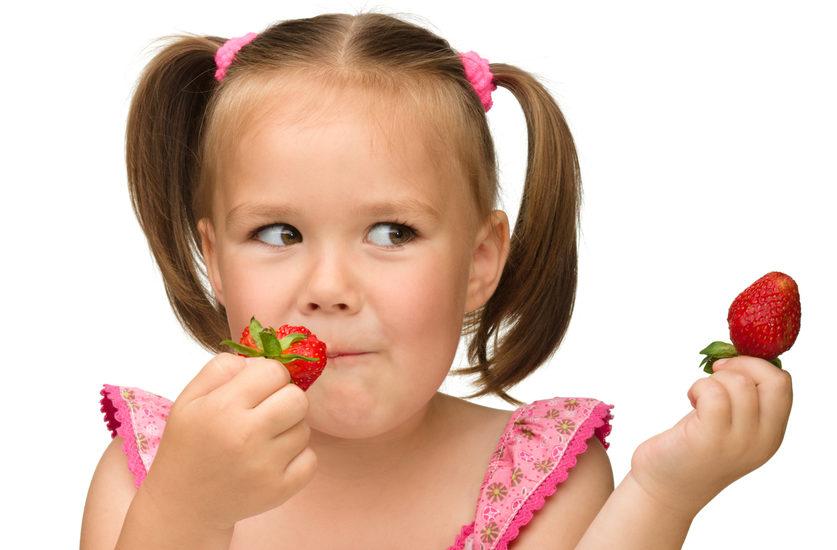
Feeding strawberries with yeast
Lately, it has been advised to feed everything with yeast, including strawberries, promising unprecedented harvests. They are said to stimulate the growth of beneficial microorganisms in the soil and help plants absorb organic fertilizers faster.
- In fact, no professional fruit grower would recommend yeast - there is not a single scientific study that would confirm their effectiveness, - says agronomist Svetlana Mikhailova.
But it is known for sure that they, being mushrooms, actively absorb potassium and calcium from the soil during reproduction. Namely, potassium is needed by strawberries during fruiting. So yeast can do more harm than good. Therefore, it is better not to experiment.
Popular Questions and Answers
We talked about feeding strawberries with agronomist-breeder Svetlana Mikhailova.
Is it harmful to feed strawberries with mineral fertilizers?
It is often said that mineral fertilizers can spoil the soil over time.

 4 mg
4 mg 

